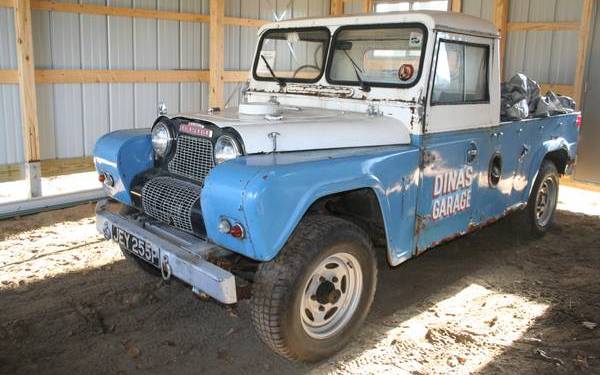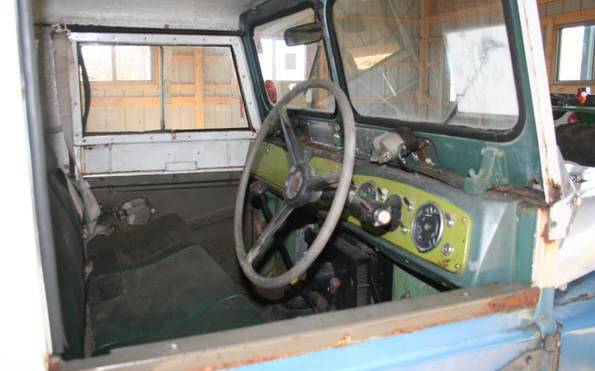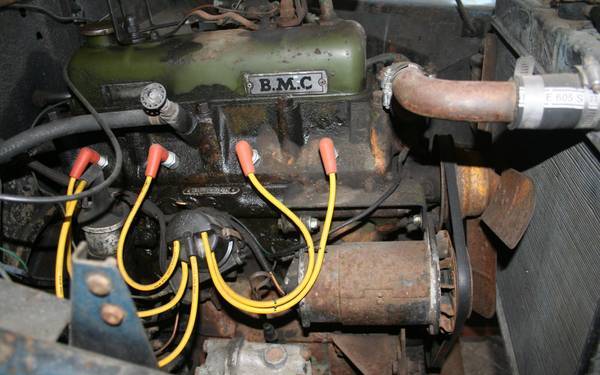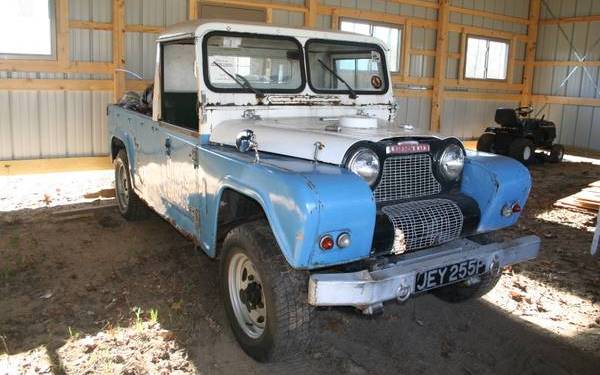Editor’s Note: This find was written up by Brian Birkner. He may be joining the team and this is his first submission. Let him know what you think!
Many of us desire a vehicle that is unique and different from the humdrum world of automobiles. This Austin Gipsy fits the bill resembling that of a Land Rover, or maybe even brings thoughts of a British Toyota Land Cruiser. The Gipsy was produced from 1958-1968. This 66 model is a little rough around the edges, but looks to be a suitable driver. We can only imagine how much fun it would be to drive off road. You can find this 1966 Austin Gipsy listed here on craigslist in Winamac, Indiana for $5,500.
The Gipsy is very minimalistic to say the least. It is rusty, but it appears to have solid bones and to be mostly complete. The seller claims that it is an ex-British Military truck, which only makes it more interesting. BMC only produced a little over 21,200 Gipsys. This one is a long wheel base pick-up, featuring an enclosed cockpit versus an open canopy style roof, which would make day to day life with this Gipsy much easier. The interior is basic for certain, but has a clean and simple appeal like an early Land Rover. The Gipsy also has removable windows much like that of a series 1 or 2 Austin Healey Sprite or the similar Land Rover too.
The vintage paint scheme of this Gipsy has such a great look. It would be tough to decide whether to restore, or leave as-is before enjoying the open wilderness and cutting your own trails. The seller claims that it has a rusty body, but a solid frame and that a fiberglass windshield frame will be included with the sale of the vehicle. It would be nice if the seller could further elaborate on the rust situation, as well as provide some further history of the vehicle and its possible British military past.
The Gipsy is powered by a 2.2 litre BMC engine mated to a 4-speed manual transmission with a hi-lo transfer box. That engine may be from the same family that powered the Austin-Healey 100-4, but it only put out 62hp @ 4,000rpm and 110 lbs/ft @ 1,500rpm. Engine bits will be easy to find, but don’t fret about the rest because there are still Gipsy specific parts around. The Gipsy also has a very low compression ratio which is wonderful if you live in the Southwest or other regions that do not have higher octane fuel. Wonder how it does in four low…
This Gipsy could be a great opportunity for an enthusiast who is in the market for an unusual classic type of truck, or someone who isn’t quite willing to pony up the full cost of a vintage Land Rover, or even Land Cruiser. This Gipsy is certainly unique and has a great street appeal. With a little TLC, some elbow grease, and a fuel pump, you could easily be on the road with this interesting British pick-up. There are so many options. It would be a great camper hauler, 4×4 toy, or plainly and simply a street driven classic. What would you do with your Gipsy?





These things use rubber as their springs.. Think of a control arm bushing that’s about 10″ in diameter.. Independent suspension too.
Nice write-up Brian. Matt, this one probably does not have the Flexitor rubber suspension you refer to. They went to leaf springs on the LWB later series known as the G4M15 which this one is. This is not necessarily ex British Military just because it is right hand drive and appears to have been green. The British Civil Defense Service and Auxiliary Fire Service ordered a fleet of these and they were finally released to the public as virtually new cars ….nearly 20 years after their purchase! Some of those made it here as right hook also, but some Gipsy’s actually were sold in the USA and Canada and survive as Left Hand Drive. They are incredibly rare, and outstanding vehicles. Seek out the websites that deal with these vehicles, especially the Austin Gipsy site at AustinGipsy.net. I have a LHD version of this Gipsy and had a series 2 short wheel base with the Flexitor suspension and Austin’s diesel engine. The gasoline engine is much more usable on the road; the four wheel drive is superb; parts are easily found and the bargain entry price makes this a great find.
Nice job Brian. You did your homework.
I’ve always though that the Austin Gypsy was an interesting alternative to the much more common Land Rovers.
I do kind of wonder how/when this UK/RHD version ended up over in the USA? “Dinas” is in Wales (actually there are more than one place in Wales named Dinas) so I’m pretty sure that “Dinas Garage” painted on the door would been in Wales.
Interesting submission, very rare vehicle, and good information and writing. I think you have your newest staff writer.
These are very rare over here, and are pretty much unknown. From what I remember from Brit car magazines and auction reports, I think these would have as much value as comparable vintage Land Rovers in the UK, maybe more.
It has been on CL for 17 days with no sale. That’s one of the least effective ways to sell an unknown vehicle like this in the US. I think it would be worth advertising it in the UK. I’ll bet there would be interest in it over there, especially with the RHD.
Nice writeup, Brian! And I’d love to have the Gipsy, too :-)
What is the streetability truly like? We know its loud and rough riding thats to be expected.
Age alone, nevermind the utilitarian nature usually means painfully slow acceleration and restrictive top ends. Is this the case and is it easily addressed, perhaps by regearing?
If it’s LR-like, it might have a PTO to which you can mount on overdrive. As with old LR’s, you want to insure the bulkhead is solid.
Great write-up, Brian! However, I would check this one very, very carefully. It has been bouncing around Craigslist for over three years. The first ad said ‘body good but frame has rust’. Now it says ‘frame is good but body has rust’. I’m guessing it has rust all over. On the other hand…the long wheelbase Gypsy is very rare, even back over in the UK. I’ve seen 21 other Gypsy’s for sale in the US and Canada, only one other was the long wheelbase version, and it was turning back into ferrous oxide in Nova Scotia.
Well done Brian. Keep up the good work.
Nice write up and it looks like an interesting vehicle. Would certainly be an interesting driver. Make sure the drive train and brakes are up to the task, fix any major tin worm issues and drive it. I’d be curious to know the off road capabilities. I had a ’48 Willy Jeep that was nothing short of a mountain goat. It would consistently go places I didn’t think it could go… it certainly wasn’t a speed queen but it definitely had grunt.
Some of these were built with Rolls-Royce four-cylinder industrial engines. Many years ago I was on a Bentley rally in Oregon near Mt. Hood. We pulled into a farmer’s driveway to turn around but before I could get it in reverse he approached and asked if we wanted to see his “Rolls-Royce Jeep.” Now me, having bad hearing got really excited because I thought he said something about a “Rolls-Royce cheap!”
Now for a little bit of obscure history related to the Gypsy: The Vanden Plas Princess 4 liter “R”.
In the early 1960s, with the Rolls-Royce Silver Shadow taking shape, the company made the decision NOT to “badge-engineer” the Bentley, as exactly the same as the Rolls-Royce except for it’s identification marks.
So they turned to Austin/Leyland. They entered into a contract to have Austin build the new Bentley, a much smaller car than the Silver Shadow. The contract called for 4,000 cars to be produced during the model run.
At the last hour Rolls-Royce came to their senses, and tried to cancel the project. Austin pointed out they had a contract to install 4,000 Rolls-Royce engines in Austin chassis.
Since Rolls-Royce V8 engines would never fit in the smaller Austin chassis, they had planned to install a different Bentley engine in the new car.
Plus on the realization they had to stand behind the contract terms, Instead of supplying the originally planned new Bentley engine, and since the Gypsy was already installing a Rolls-Royce engine in the Gypsy, Austin was offered 4,000 additional Gypsy Rolls-Royce units, a 4 liter F head 6 cylinder. This engine was built not by the Rolls-Royce automotive division, but their industrial division.
So the car started out as a slightly different version of the BMC 3-liter car. It was contracted to the coach building division of Vanden Plas, where a upscale all leather interior was installed, with plenty of wood veneers on the dash, door panel tops, and a pair of folding picnic tables. The fins on the 3-liter car were eliminated, replaced with a pair of very nice looking horizontal taillight assemblies.
The car was released to the public as the Vanden Plas Princess 4 liter “R”. They were not permitted to place any type of Rolls-Royce emblem on the car, except for the single “Double R” emblem cast into the valve cover of the engine. Once the 4,000 engines were installed, the contract ended.
I’m not going to go into the inherent problems with this engine, but a typical “R” type Princess rarely has more than 30,000 miles on the engine before requiring a rebuild. [Hint – it was an all aluminum engine with wet liners]
Also of note: The larger Vanden Plas Princess limousines built between 1952 & 1968 were also 4-liter 6 cylinder engines, mated to the same GM Hydra-Matic automatic* as used in the Rolls-Royce & Bentley from 1952 to 1968, but the engine is derived from the large Austin truck engine, not a Rolls-Royce engine. [The same basic engine used in the Austin Healey, but as a 3-liter]
*The Hydra-Matic was built under license for Rolls-Royce & the big Princess limo, by Hersey of France. It does not fit US built cars [GM, Lincoln & Kaiser vehicles], but the internal parts do interchange.
Very interesting stories, thank you. About the engine, “all aluminum with wet liners.” That also describes the Silver Shadow engine and it’s the most reliable and long lasting part of the whole car.
Re the Hydramatic – this is the first and only time I ‘ve heard that they were built in France. I know some of the very earliest units were actually made by GM, and I’ve also had some clearly marked as being made by Rolls Royce and of course there is the famous story that at first Rolls Royce built them to too precise a specification and they didn’t work properly until they relaxed their tolerances to match the American built transmissions. I’ve always used ‘generic’ American parts when rebuilding one with great results yet there are still those stalwarts in the Rolls Royce Owners Club who insist on paying three or four times what I do for what they believe are ‘genuine’ parts. Personally I think these parts come from the same source, they just make a few unneeded trips across the Atlantic!
A factory photo of the Vanden Plas Princess 4-liter “R”, from my Vanden Plas photo collection.
Some corrections for the discussion here. The Austin Gipsy (correct spelling of the car is with an i not a y) only used the 2.2 liter Austin Petrol engine and a similarly sized robust diesel which gained fame in the Austin Taxi and is virtually indestructible. My first Gipsy was a diesel which started up after sitting for 25 years! I may be a glutten for punishment but I have also owned two left hand drive Vandenplas Princess 4 liter R cars. Both were Californian, rust free, and left hand drive. That engine was used in the Austin Champ which preceded the Gipsy and did have some military use in the UK. It never came in a Gipsy. That particular industrial Rolls Royce engine also found its way into Dennis Ambulances and a few other applications. I did not find any need to rebuild these engines at 30K miles. They did however often need head gasket replacements at that point, unless well maintained with frequent retourqing of the head and a high concentration of coolant and anti corrosive . A bit of “Alumaseal” helped also, just like in an Alfa. Right now, no VDP Princesses, but another left Hook Gipsy- a G4M15 which is a long wheelbase version, graces my driveway. Somebody should save this one. It will earn its keep as a worker , and can be tons of fun off-road.
And a slight clarification to the corrections. The VDP 4 liter R used the FB 60 version of the engine, which was six cylinders. The champ used the shorter FB40 4 cylinder version. (Phew). Any wonder British Leyland struggled so much after being formed from the merger of all these competing car companies. Rover cars challenged Triumphs Saloons. Austin Gipsies competed with Land Rovers. MG vs. Triumph and the list went on. Sad these great companies ate each other up (with labor problems helping the collapse). This site does such a wonderful job of finding homes for so many of these great cars…….not Museum pices or jewels to trade at auctions. DRIVERS cars and trucks. Grab one. Thanks so much BARN FINDS!!
This is the old tow truck of Dinas Garage who had premises in Llanwnda, Caernarfon (then in Caernarvonshire, now Gwynedd) and in Llangefni, Anglesey, both in North West Wales. I well remember this vehicle in service. My parents purchased at least 4 vehicles from this dealer who was mainly an agent for Austin, for a short while Ford and ultimately Vauxhall. Although the original premises were sold for other retail use, a Vauxhall dealership, albeit in different ownership remains, erected on what was a field used for storage of used and scrap vehicles. I don’t think that this vehicle ever saw military service, as the British military never purchased any. It carries an Anglesey plate issued in about 1967/68.